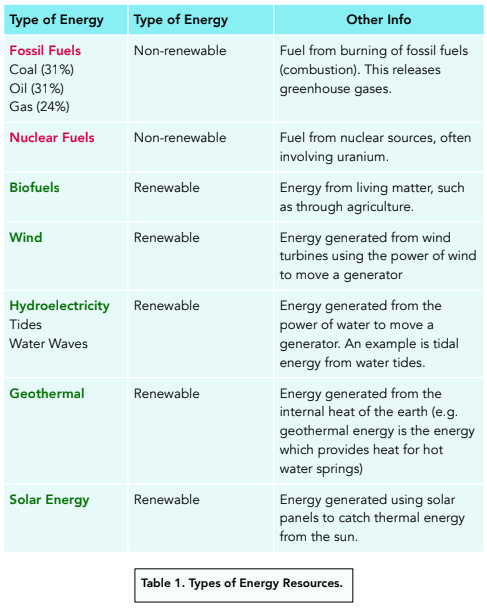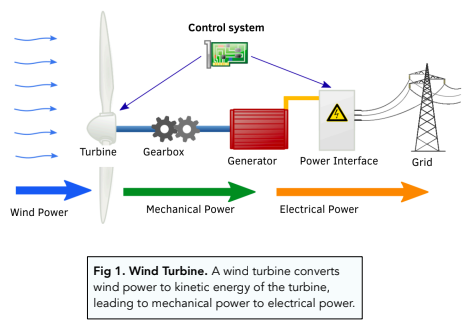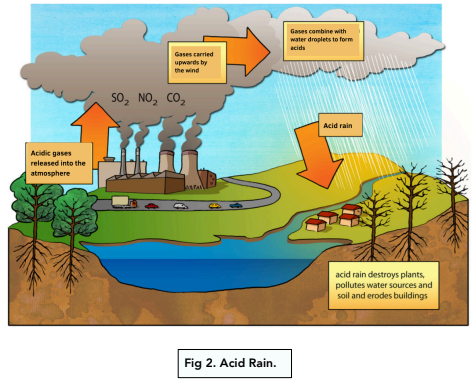Energy - 1.3 National and Global Energy Resources (GCSE Physics AQA)
National and Global Energy Resources
Energy Resources
The following table shows the main energy resources available for us to use on Earth.
The percentages show how much each resource contributes to our total energy usage. The resources without a percentage make up a very small amount of our overall energy usage.


Renewable Energy Resources
- Renewable energy can be replenished. Renewable energy resources are replenished as they are used up (or they will be replenished later). One advantage of renewable energy is that we will never run out of these resources.
- Renewable energy doesn’t damage the environment. Another advantage of renewable energy resources is that they don’t cause much damage to the environment. This is much better than non- renewable resources, which produce greenhouse gases that are quite harmful to the environment.
- Renewable energy isn’t very reliable. However, renewable energy resources are not always the most reliable forms of energy. As you can see from the table, a lot of renewable energy resources depend on the weather, such as the Sun, wind and waves. These are quite unpredictable, meaning that we might not always get a steady supply of energy when we need it.
Uses of Energy Resources
We use energy resources for many things in everyday life. Here are three common uses:
- Transport – we can use both non renewable and renewable energy resources as fuel for transport. In terms of a non-renewable resource, components of oil (petrol and diesel) can be used to fuel cars. As for renewable resources, some cars run on biofuels, which can be derived from vegetable oils.
- Electricity Generation – we can use some renewable energy resources to generate electricity, such as solar power. Some buildings have solar panels attached to the roof, which can convert sunlight into electricity. Wind turbines can also do a similar job; the rotating blades will turn a generator which will generate electricity.
- Heating – energy resources are necessary to create thermal energy to heat up buildings. Commonly, we use natural gas to heat up water which then runs through radiators in a house. If not, we can use renewable energy resources, such as biofuels or solar panels (except we aren’t making electricity, we will be using the energy to heat up buildings).
Trends in Usage
The energy resources that tend to be used most often are the non- renewable resources. These are the most reliable resources, which include fossil fuels and nuclear fuel. They are more reliable than renewable energy resources, which depend heavily on the weather (which is out of our control).
However, these non renewable energy resources have some negative environmental impacts, which we will discuss in the next section.
Environmental Impact
There are several issues caused by non-renewable resources:
- Greenhouse gases – as previously discussed, burning fossil fuels cause to the environment through the production of greenhouse gases. When burnt, non renewable resources release carbon dioxide into the atmosphere. This CO2 contributes to global warming.
- Acid rain – also through the burning of fossil fuels, we can produce sulphur dioxide, which causes acid rain. The SO2 gas is released into the atmosphere, mixes with rain and produces acid rain. This acid rain can damage buildings, kill fish in lakes and also be harmful to trees.

- Radioactive waste – when we use nuclear fuels, we create extremely harmful radioactive waste. This waste is very difficult to get rid of and causes damage to the environment and humans.
- Oil spillages – accidentally, tankers, barges and pipelines can leak into the ocean, causing oil spillages. These spillages of oil will pollute the oceans and harm marine life.
Although we know about these environmental effects of using certain energy resources, we cannot always combat these issues. This is because of the following considerations:
- Political – sometimes governments try to introduce charges and taxes to discourage people from doing certain things. For example there is a Congestion Charge in London, where drivers have to pay a fee to be able to drive in a particular area of the capital at certain times. By doing this, the government hoped to decrease the pollution in the capital from fossil fuels.
- Social – although solar panels and wind turbines are good non renewable energy resources, some people don’t want panels on their roof, or a turbine plant in their back garden. These are forms of ‘visual pollution’, which spoil an otherwise aesthetically pleasing view.
- Ethical – when we use nuclear fuels, we produce lots of radioactive waste. This waste is extremely harmful and stays dangerous for hundreds of years. It can be argued that it is unethical to create this type of waste, since it has a tremendous impact on future generations.
- Economical – many renewable energy sources involve a large amount of money to set up. For example, building solar panels, wind turbines and cars that run on biofuels are all incredibly expensive to make. We have to consider whether all these start up costs will be beneficial in the long run.
Energy resources can be divided into two main categories: renewable and non-renewable. Renewable energy resources include solar, wind, hydro, and geothermal energy, while non-renewable energy resources include fossil fuels such as coal, oil, and natural gas.
Renewable energy sources are significant because they are unlimited and do not emit harmful pollutants like greenhouse gases. They are also considered more environmentally friendly than non-renewable energy sources.
Non-renewable energy sources are significant because they are still the primary source of energy for many countries, providing a reliable and relatively cheap source of energy. However, they are finite and the extraction of these resources can have negative environmental impacts.
Some examples of global energy resources include coal, oil, natural gas, and uranium. These energy resources are found all over the world and are used to generate electricity, power vehicles, and heat buildings.
National energy resources vary depending on the country, but can include renewable energy sources like wind and solar power, as well as non-renewable energy sources like coal, oil, and natural gas.
It is important to consider the sustainability of energy resources because the demand for energy is increasing and the finite supply of non-renewable energy sources will eventually run out. Additionally, the extraction and use of non-renewable energy sources can have negative environmental impacts, so it is important to find alternative, sustainable sources of energy.
Energy efficiency is the practice of reducing the amount of energy needed to perform a task. It is important because it helps to reduce the amount of energy we use and can lower energy costs and reduce greenhouse gas emissions.
The role of government in managing national and global energy resources is to ensure that energy resources are used in a sustainable and environmentally responsible manner. This can involve implementing regulations and incentives to encourage the use of renewable energy sources and reduce the use of non-renewable energy sources.
Energy production can have a significant impact on the environment, including air and water pollution, deforestation, and the emission of greenhouse gases that contribute to climate change. It is important to find sustainable energy sources and to reduce the environmental impact of energy production.






Still got a question? Leave a comment
Leave a comment